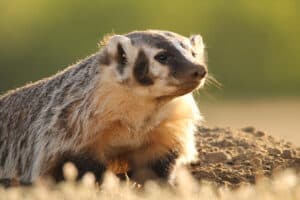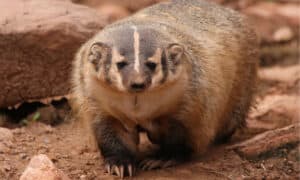Badgers spend most of their life in complex underground tunnels. They hang out in nesting chambers called a sett, and things can get cozy. Badgers of all ages live together and ass many as 23 members might be living in a sett. However, some have as few as two residents. Whatever size group it is, new members are a common occurrence as a female badger can have as many as five babies in one litter. What is life like for these small, fierce creatures? Read on to learn 10 incredible badger facts.
1. Badgers Can Weigh Over 20 LB

An adult badger can weigh as much as 26 lb.
©Jonathunder, CC BY-SA 3.0, via Wikimedia Commons – License
First, on our list of incredible badger facts, let’s talk size. A full-grown adult badger can weigh as much as 26 lb! On the smaller side, they can weigh as little as 8.8 lb. However, a typical badger is between 1.7ft to 2.8ft long. Badgers are best described as short and sturdy. They have stumpy tails, flat bodies, and tiny legs. The badger’s face is triangular, making it perfect for nosing into the tightest spaces. They also have loose fur and strong necks.
2. Badgers Are Built for Defense
All badger species, including the American badger, are ready to fight. Their thick fur and muscular necks help them fight off even the strongest prey. They have multiple defense systems, with vocalization being one. If an American badger feels threatened, you’ll hear about it. They vocalize when under duress by growling and hissing. These incredible mammals even can emit an unpleasant musky odor. The defensive odor isn’t as strong as a skunk, but it can still do the trick. As if their muscles, thick fur, and growl weren’t enough, badgers also have long curved claws. Their webbed front feet have large front claws, and their back feet have large claws too.
3. A Badger in Utah Buried an Entire Cow

A badger in Utah buried an entire cow carcass.
©Clara Bastian/Shutterstock.com
A badger in Utah impressed everyone when he buried an entire cow carcass. This is the first recorded occurrence of an American badger burying such a large animal. Scientists were dumbfounded as they watched the 16 lb badger spend 4 days burying a 50 lb calf carcass.
Why would a badger want to bury a cow? Because they’re tasty! Badgers are omnivores, eating a varied diet which includes prairie dogs, groundhogs, and insects. Sometimes Badgers will even catch food and wait to eat it for later. That’s what the Utah badger did when it took on the cow. It was just meal-prepping!
4. Badgers Hang With a Rough Crowd
Badgers have a unique friend circle that includes large animals. For instance, in certain parts of the United States, you can find badgers and coyotes hunting together. However, the alliances aren’t long-lived. Sometimes animals have a mutualistic relationship. They’ll form a temporary alliance that’s mutually beneficial. It’s a way of different species working together to serve their primary needs. Instead, badgers take advantage of prey running away from the coyote. When the coyote drives the prey underground, the badger strikes. Everyday prey would include ground squirrels, prairie dogs, or anything else that likes to burrow.
5. Honey Badgers Make Horrible Pets

It’s illegal to own honey badgers as pets.
©Erwin Niemand/Shutterstock.com
One of the most important incredible badger facts; watch out for honey badgers. When you hear the name honey badger, you might assume they’re sweet and kind, but the opposite is true. Honey badgers are so aggressive they make one of the worst pets possible. They never tame and only thrive in the wild and in quality zoo enclosures. Even though honey badgers are small, they can do a lot of damage. Measuring between 9 to 11 in tall and around 22 to 30 in long, the species has a reputation for wanting to fight. Since the 1973 badger act, keeping these mammals as pets has been illegal. That includes the less aggressive European badger.
6. Sleeping Is a Badger’s Favorite Pastime
If badgers could talk, they’d tell you that sleeping is their favorite pastime. As nocturnal predators, badgers enjoy sleeping the day away in cozy dark dens hundreds of metres long. When deep winter rolls around, an American badger can sleep for weeks! When a badger enters into a deep sleep, whether it lasts days or weeks, it’s known as torpor. During torpor, the badger’s heartbeat slows down and enters a hibernating-like state. However, badgers don’t enter into a full hibernation like bears do.
7. Badgers Are Promiscuous
Monogamy only benefits some animal species. Other animals, like badgers, are promiscuous. By having multiple partners, badgers help guarantee the survival of their genetic code. The mating season for badgers usually starts in late summer and continues until early autumn. Badgers remain single until the mating season rolls around. When it begins, it’s typical for males and females to have multiple partners.
8. Badgers Appear in a Lot of Movies
There are a ton of movies that showcase badgers! Take, for instance, The Boy Who Talked To Badgers. The Disney film came out in 1975, starring Christian Juttner and Carl Betz. The movie tells the captivating tale of a 6-year-old farm boy who gets lost in the wilds of Canada. Thankfully a friendly badger comes along to help save the day. Other badger movies include Peter Rabbit, Fantastic Mr. Fox, and Watership Down.
9. Badgers Have a Third Eyelid
Badgers are fossorial creatures, spending a lot of their time digging belowground. Their underground lifestyle contributes to one of the most incredible badger facts; they have a third eyelid!
Why the extra skin? Badgers have a third eyelid to keep the dirt out of their eyes. The eyelid helps keep the badgers safe from other bits of debris too. They also have thick guard hairs in their nostrils and ears to keep out dirt and debris.
10. You Can’t Dislocate a Badger Jaw

You can’t dislocate a badger’s jaw.
©Sinisa Botas/Shutterstock.com
Last on our list of incredible badger facts; they have impressive jaws. American badgers have a unique jaw structure. The jaw sits in the skull with a special notch that locks the upper mandible into place. This makes it impossible to dislocate an American badger’s jaw.
Badgers need strong jaws to stalk and dislodge prey, like prairie dogs. A prairie dog will use its strong legs to push against walls and wedge itself into place. Thankfully, the badger’s specialized jaw and stout neck help it dislodge its quarry almost every time.
Up Next
- 10 Incredible Ferret Facts
- 10 Incredible Mink Facts
- American Badger vs European Badger: 5 Key Differences Explained
The photo featured at the top of this post is © Coatesy/Shutterstock.com
Thank you for reading! Have some feedback for us? Contact the AZ Animals editorial team.






